Review Yota Many
In early June, the company Yota introduced two new devices to work in their network, Yota One and Yota Many , read more about which you can on our website. For today I prepared the review of the "senior" novelty - welcome under kat.
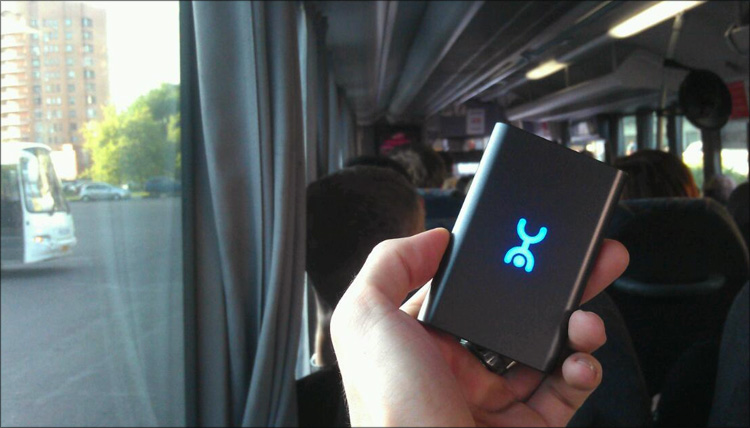
In fact, Yota Many is just a mobile access point that distributes the Internet via Wi-Fi. Almost exactly the same as it did Yota Egg, which I already wrote about . But this is where all her charm lies - turned it on, put it in a backpack, and you have fast internet wherever you go or go. But there is a novelty and a difference - so significant that I switched to it without the slightest hesitation.
')
Battery : 3.7 V, 1500 mA / h, Li-Ion, 5.55 W / h
Dimensions : 90 × 60 × 13 mm
Weight : 75 g
Compatibility with OS : Windows XP SP3 / Vista / 7, Mac OS X 10.5 / 10.6. Linux and other operating systems that support CDC / RNDIS devices
Connection Interface : USB 2.0, Wi-Fi
 WiMAX
WiMAX
Technology Standard : IEEE 802.16e
Frequency range : 2.5-2.7 GHz
Signal power : 200 mW
 Wi-Fi
Wi-Fi
Technological standard : IEEE 802.11b / g
Frequency range : 2.4 GHz
Signal power : 3 mW
Antenna : built-in
Yota Many comes in a transparent plastic cylinder (which can later be used for every little thing) - everything is securely fixed.

In addition to the device itself, the kit included:
- USB-microUSB wire
- Cradle with a suction cup to mount the device anywhere
- A set of "sticky" for the cradle (prudently)

I think it's great. If during the time of Yota Egg I had to remove the device in the glove box of the car (and in it I often need an Internet), now the device can be fixed anywhere - for example, on a torpedo (for better reception). Similarly, in the office, the device can be stuck on the window - this is all, of course, ridiculous, but often this life hack gives a significant increase in connection speed.
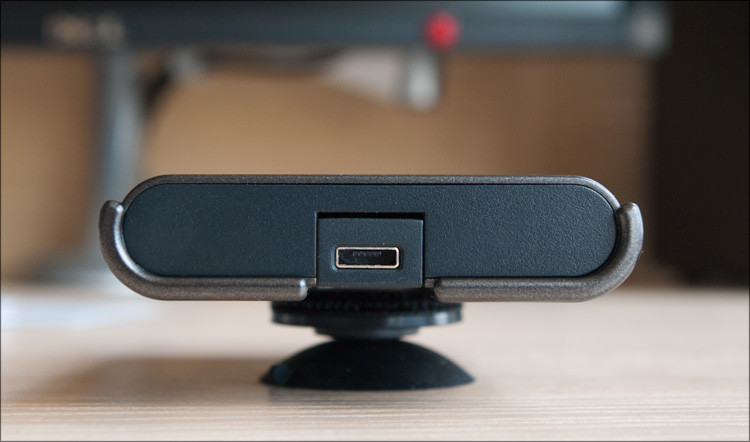
The device is as simple as possible, but despite this, it received a rather unique design - at least I don’t know with what it could be confused. Or compare. A smaller pack of cigarettes and less phone ... but at the same time thicker than a credit card. However, what's the difference - the main thing is that less than it was before. Perceptibly smaller and lighter.
Compared to HTC Sensation:
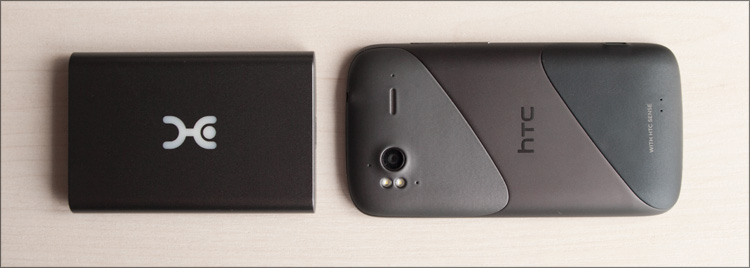

Yota Many is made entirely of matte plastic in the color of “wet asphalt” - there are no complaints about the assembly (by the way, there is only one solid body). From above - the company logo in the form of an inverted man (by the way, his name is Nuf - from the "inverted" word Fun ).
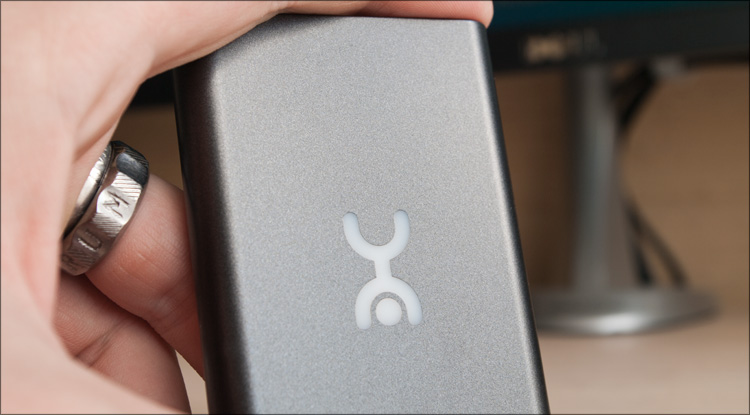
From one end is the power button and switch to share the network.
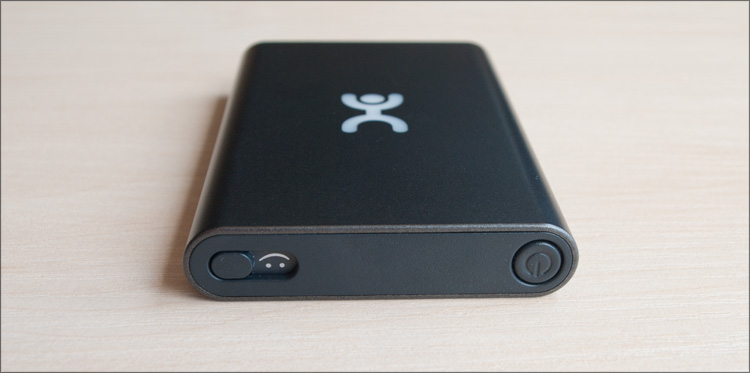
On the other hand - the microUSB connector (for connecting via wire).

With a flick of the wrist, the same connector turns into ... turns into ... rotate ... into an elegant USB connector!

Under the USB-connector is a sticker with useful information - the serial number of the device and the MAC-address.
Nowhere does the company name appear anywhere - I respect when manufacturers do not abuse it.
If the device is located in the Yota network zone, then Fun will light up with an unobtrusive blue light. It is a pity that this glow can not be turned off. At the same time, white “dots” appear on one of the sides, signaling the battery charge level - extremely convenient and much more informative than in the Yota Egg (where the tri-color LED was just - before leaving for the conference it could be green, and after 5 minutes - orange. So I was left without a couple of times, considering that the battery life of the “egg” is only 5-6 hours)
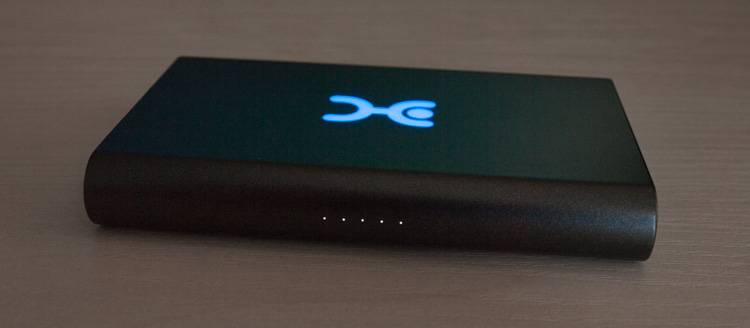
As I said above, under the USB-connector is a sticker with the MAC address of the device. The last three characters of this address are part of the network name that the Many device creates around itself (that is, if the mac address ends with " F73 ", then the personal network will be called " Yota F73 ").
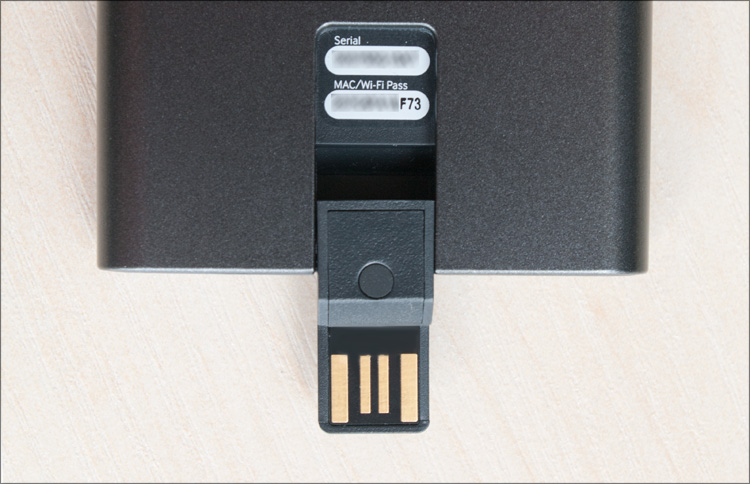
Moreover, this address is a password for connecting to the network - another plus, since the password is complex and unique. For comparison - in addition, the “eggs” could easily enter the admin area if the admin login and password were not changed;here there is simply no admin there - read below)
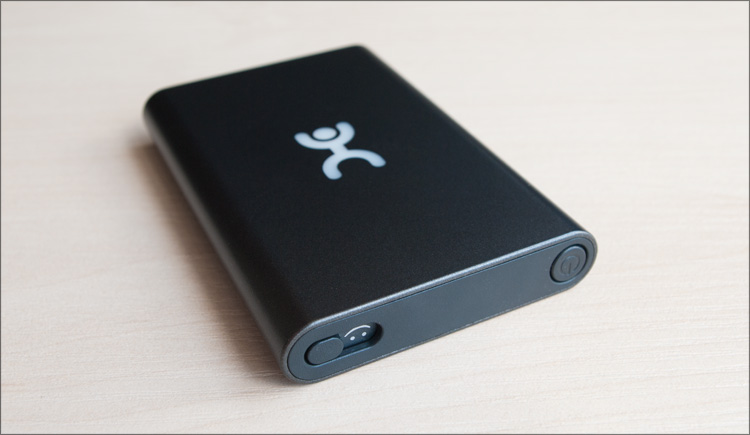
What is the chip switch located on the end of the device? If earlier (in the case of Yota Egg), you had to protect your network with a password (and, accordingly, tell this password to your friends), now everything has become easier. If “off” - only you use the Internet, if enabled (the smile will be visible), another “ Yota Share ” network will appear, to which up to 8 more people can connect. And without a password. Conveniently!
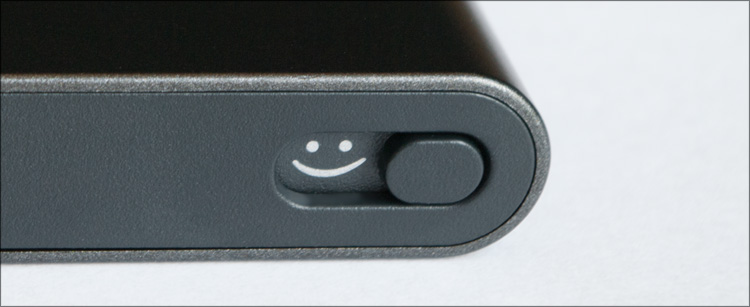
And friendly :)
I didn’t spend accurate measurements of battery life, but this time is definitely longer than a working day. If you believe the manufacturer, then in the mode of distribution Wi-Fi device works up to 24 hours, and in the mode of intensive data transfer - about 10 hours. Anyway great. Full charge time - 2.5 hours, and if you charge from the USB-port and at the same time use the device, then 4 hours.
I like the speed - living in the center and in the South-Eastern Administrative Okrug, easily it turns out to watch streaming video, listen to music from the network, receive-send mail, use twitter and other instagrams.
At the moment, Yota Egg has no advantages as such - almost everything in it is multiplied in Yota Many. But one significant difference is still there - at Egg, at 192.168.1.1, there is an admin panel in which you can set the network name, password, and do port forwarding. In Many, you will have to be content with the network name that the manufacturer will supply you with, the password will also have to be remembered. On the other hand, you only need to know the password in Many, since the network shared by pressing a button is open.
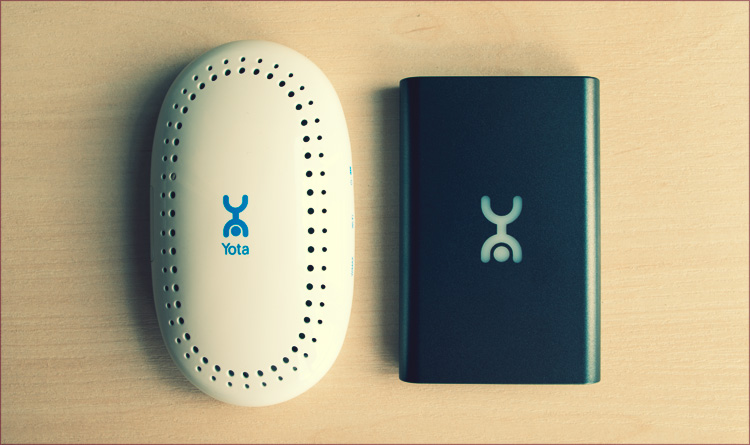
Well, in detail. Yota Egg has more dimensions and weight, only 5-6 hours of battery life, a not very informative indicator of battery charge and a non-standard power connector. In Many - comfortable for everyday use dimensions, a day of battery life, the ability to use a finger to treat your friends with the Internet, as well as the ability to work directly from USB. Moreover, the device can be plugged into the USB-connector of the same laptop, and connected via a wire with microUSB.
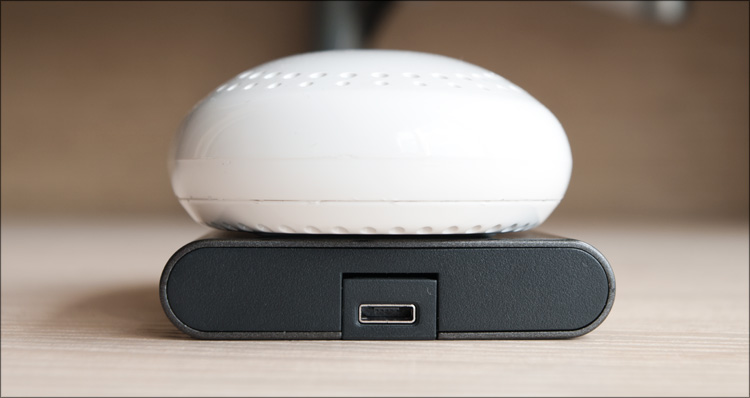
If you disassemble the Egg, then it turns out that there are several connectors for connecting external antennas inside - perhaps something similar is provided for in Many, but I don’t want to poke around in it, since everything initially works without complaints. Yes, and the body, apparently non-separable.
 Compact housing made of quality material
Compact housing made of quality material
 The possibility of mounting the device on the suction cup
The possibility of mounting the device on the suction cup
 3 connection options (USB, microUSB, Wi-Fi)
3 connection options (USB, microUSB, Wi-Fi)
 Long battery life (up to 24 hours)
Long battery life (up to 24 hours)
 Informative battery charge indicator
Informative battery charge indicator
 The ability to "share" the connection with a single click
The ability to "share" the connection with a single click
 Cross-platform - no need to install any software
Cross-platform - no need to install any software
 The glowing logo can not be turned off, and he eats too
The glowing logo can not be turned off, and he eats too
 Expensive
Expensive
4900 rubles are written on the official price tag of the device. By the way, on the price tag Yota Egg is written 90 rubles more.
There are no complaints about the device: the engineers did their best and thought through every detail, so the impressions are exceptionally good. I liked the battery life most of all - if I use the device for several hours every day (on the way to and from work), I have only one charge for a week. If, however, to use more actively, the time is an "honest" day, that is, 4-5 times more than what Yota Egg was capable of. And all this despite the fact that the novelty turned out to be much more compact.
Another question is the price of the Internet itself from the provider, as well as the coverage area (do not forget about the “ Week to try ” action that applies to this device). This is a topic for a separate article, now I don’t want to argue on this point, but for myself I decided a long time ago :)
I repent - I did not read the manual) It turns out that the device still has an “admin” - you need to go to status.yota.ru - you can change the password in the same place, redirect ports.
uPnP is. WPA TKIP and AES supported. You can connect from multiple devices to a secure network. USB is needed to charge the device and connect to Yota without using WiFi - so yes, this is a killer feature Many - supports Category 4 WiMAX - up to 20Mbit, Egg - Category 3 (12 Mbit).
Device Setup (admin) | We disassemble the device , we put external antennas
Successes!

In fact, Yota Many is just a mobile access point that distributes the Internet via Wi-Fi. Almost exactly the same as it did Yota Egg, which I already wrote about . But this is where all her charm lies - turned it on, put it in a backpack, and you have fast internet wherever you go or go. But there is a novelty and a difference - so significant that I switched to it without the slightest hesitation.
')
Specifications
Battery : 3.7 V, 1500 mA / h, Li-Ion, 5.55 W / h
Dimensions : 90 × 60 × 13 mm
Weight : 75 g
Compatibility with OS : Windows XP SP3 / Vista / 7, Mac OS X 10.5 / 10.6. Linux and other operating systems that support CDC / RNDIS devices
Connection Interface : USB 2.0, Wi-Fi
 WiMAX
WiMAXTechnology Standard : IEEE 802.16e
Frequency range : 2.5-2.7 GHz
Signal power : 200 mW
 Wi-Fi
Wi-FiTechnological standard : IEEE 802.11b / g
Frequency range : 2.4 GHz
Signal power : 3 mW
Antenna : built-in
Equipment. Appearance
Yota Many comes in a transparent plastic cylinder (which can later be used for every little thing) - everything is securely fixed.

In addition to the device itself, the kit included:
- USB-microUSB wire
- Cradle with a suction cup to mount the device anywhere
- A set of "sticky" for the cradle (prudently)

I think it's great. If during the time of Yota Egg I had to remove the device in the glove box of the car (and in it I often need an Internet), now the device can be fixed anywhere - for example, on a torpedo (for better reception). Similarly, in the office, the device can be stuck on the window - this is all, of course, ridiculous, but often this life hack gives a significant increase in connection speed.

The device is as simple as possible, but despite this, it received a rather unique design - at least I don’t know with what it could be confused. Or compare. A smaller pack of cigarettes and less phone ... but at the same time thicker than a credit card. However, what's the difference - the main thing is that less than it was before. Perceptibly smaller and lighter.
Compared to HTC Sensation:


Yota Many is made entirely of matte plastic in the color of “wet asphalt” - there are no complaints about the assembly (by the way, there is only one solid body). From above - the company logo in the form of an inverted man (by the way, his name is Nuf - from the "inverted" word Fun ).

From one end is the power button and switch to share the network.

On the other hand - the microUSB connector (for connecting via wire).

With a flick of the wrist, the same connector turns into ... turns into ... rotate ... into an elegant USB connector!

Under the USB-connector is a sticker with useful information - the serial number of the device and the MAC-address.
| The device is fully developed in Russia by Yota specialists and assembled in China by the Quanta Group. Suppliers of the main components: Wi-Fi chip - Atheros, WiMAX chip - GCT. Inside there is an antenna (2-3 dBi) and an amplifier (23 dBm). |
Turn on and work
If the device is located in the Yota network zone, then Fun will light up with an unobtrusive blue light. It is a pity that this glow can not be turned off. At the same time, white “dots” appear on one of the sides, signaling the battery charge level - extremely convenient and much more informative than in the Yota Egg (where the tri-color LED was just - before leaving for the conference it could be green, and after 5 minutes - orange. So I was left without a couple of times, considering that the battery life of the “egg” is only 5-6 hours)

As I said above, under the USB-connector is a sticker with the MAC address of the device. The last three characters of this address are part of the network name that the Many device creates around itself (that is, if the mac address ends with " F73 ", then the personal network will be called " Yota F73 ").

Moreover, this address is a password for connecting to the network - another plus, since the password is complex and unique. For comparison - in addition, the “eggs” could easily enter the admin area if the admin login and password were not changed;

What is the chip switch located on the end of the device? If earlier (in the case of Yota Egg), you had to protect your network with a password (and, accordingly, tell this password to your friends), now everything has become easier. If “off” - only you use the Internet, if enabled (the smile will be visible), another “ Yota Share ” network will appear, to which up to 8 more people can connect. And without a password. Conveniently!

And friendly :)
I didn’t spend accurate measurements of battery life, but this time is definitely longer than a working day. If you believe the manufacturer, then in the mode of distribution Wi-Fi device works up to 24 hours, and in the mode of intensive data transfer - about 10 hours. Anyway great. Full charge time - 2.5 hours, and if you charge from the USB-port and at the same time use the device, then 4 hours.
I like the speed - living in the center and in the South-Eastern Administrative Okrug, easily it turns out to watch streaming video, listen to music from the network, receive-send mail, use twitter and other instagrams.
Yota Many vs. Yota egg
At the moment, Yota Egg has no advantages as such - almost everything in it is multiplied in Yota Many. But one significant difference is still there - at Egg, at 192.168.1.1, there is an admin panel in which you can set the network name, password, and do port forwarding. In Many, you will have to be content with the network name that the manufacturer will supply you with, the password will also have to be remembered. On the other hand, you only need to know the password in Many, since the network shared by pressing a button is open.

Well, in detail. Yota Egg has more dimensions and weight, only 5-6 hours of battery life, a not very informative indicator of battery charge and a non-standard power connector. In Many - comfortable for everyday use dimensions, a day of battery life, the ability to use a finger to treat your friends with the Internet, as well as the ability to work directly from USB. Moreover, the device can be plugged into the USB-connector of the same laptop, and connected via a wire with microUSB.

If you disassemble the Egg, then it turns out that there are several connectors for connecting external antennas inside - perhaps something similar is provided for in Many, but I don’t want to poke around in it, since everything initially works without complaints. Yes, and the body, apparently non-separable.
 Advantages and disadvantages
Advantages and disadvantages
 Compact housing made of quality material
Compact housing made of quality material The possibility of mounting the device on the suction cup
The possibility of mounting the device on the suction cup 3 connection options (USB, microUSB, Wi-Fi)
3 connection options (USB, microUSB, Wi-Fi) Long battery life (up to 24 hours)
Long battery life (up to 24 hours) Informative battery charge indicator
Informative battery charge indicator The ability to "share" the connection with a single click
The ability to "share" the connection with a single click Cross-platform - no need to install any software
Cross-platform - no need to install any software The glowing logo can not be turned off, and he eats too
The glowing logo can not be turned off, and he eats too Expensive
Expensive4900 rubles are written on the official price tag of the device. By the way, on the price tag Yota Egg is written 90 rubles more.
As output
There are no complaints about the device: the engineers did their best and thought through every detail, so the impressions are exceptionally good. I liked the battery life most of all - if I use the device for several hours every day (on the way to and from work), I have only one charge for a week. If, however, to use more actively, the time is an "honest" day, that is, 4-5 times more than what Yota Egg was capable of. And all this despite the fact that the novelty turned out to be much more compact.
Another question is the price of the Internet itself from the provider, as well as the coverage area (do not forget about the “ Week to try ” action that applies to this device). This is a topic for a separate article, now I don’t want to argue on this point, but for myself I decided a long time ago :)
* UPD :
I repent - I did not read the manual) It turns out that the device still has an “admin” - you need to go to status.yota.ru - you can change the password in the same place, redirect ports.
uPnP is. WPA TKIP and AES supported. You can connect from multiple devices to a secure network. USB is needed to charge the device and connect to Yota without using WiFi - so yes, this is a killer feature Many - supports Category 4 WiMAX - up to 20Mbit, Egg - Category 3 (12 Mbit).
* UPD2 :
Device Setup (admin) | We disassemble the device , we put external antennas
Successes!
Source: https://habr.com/ru/post/122614/
All Articles